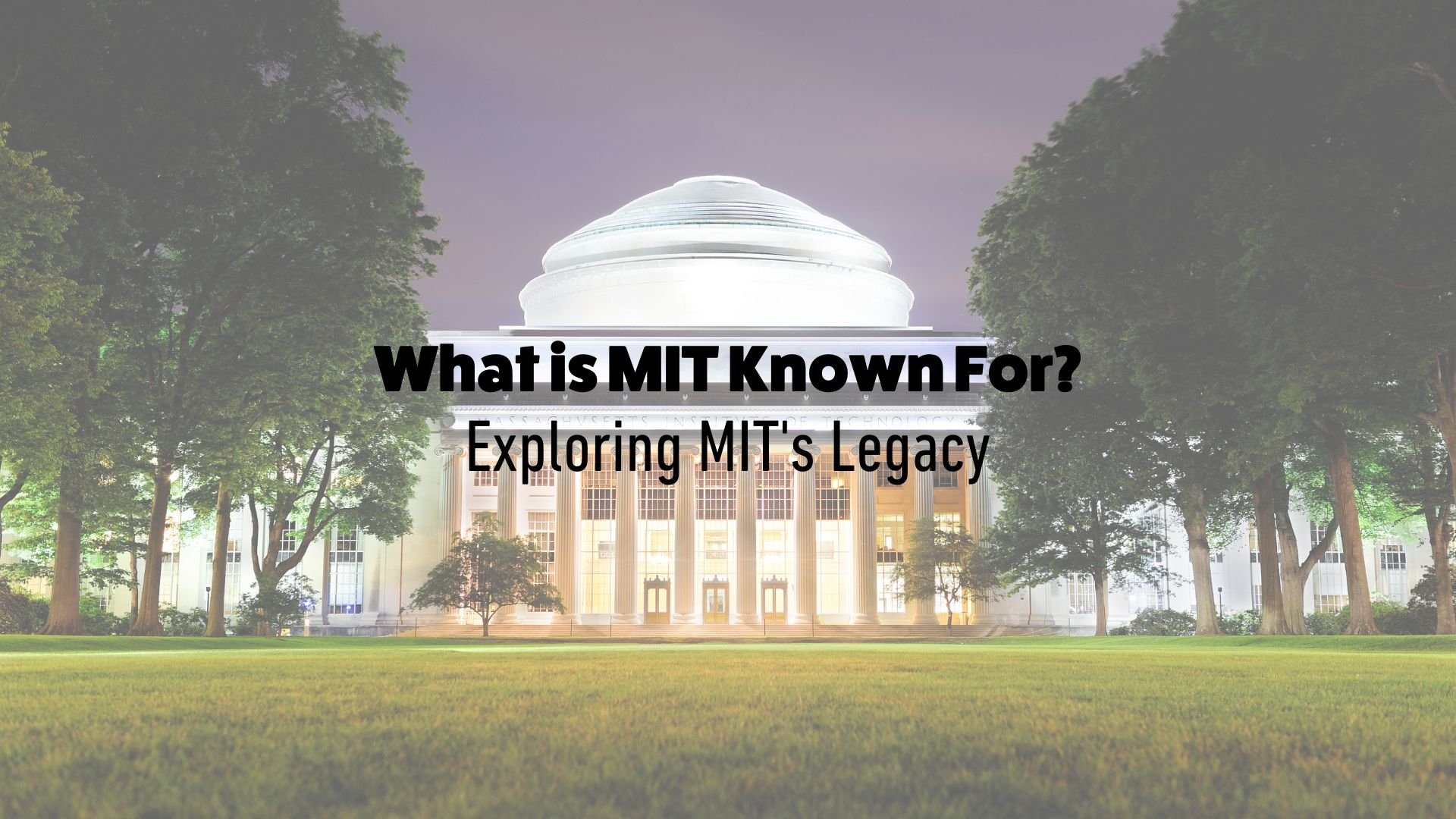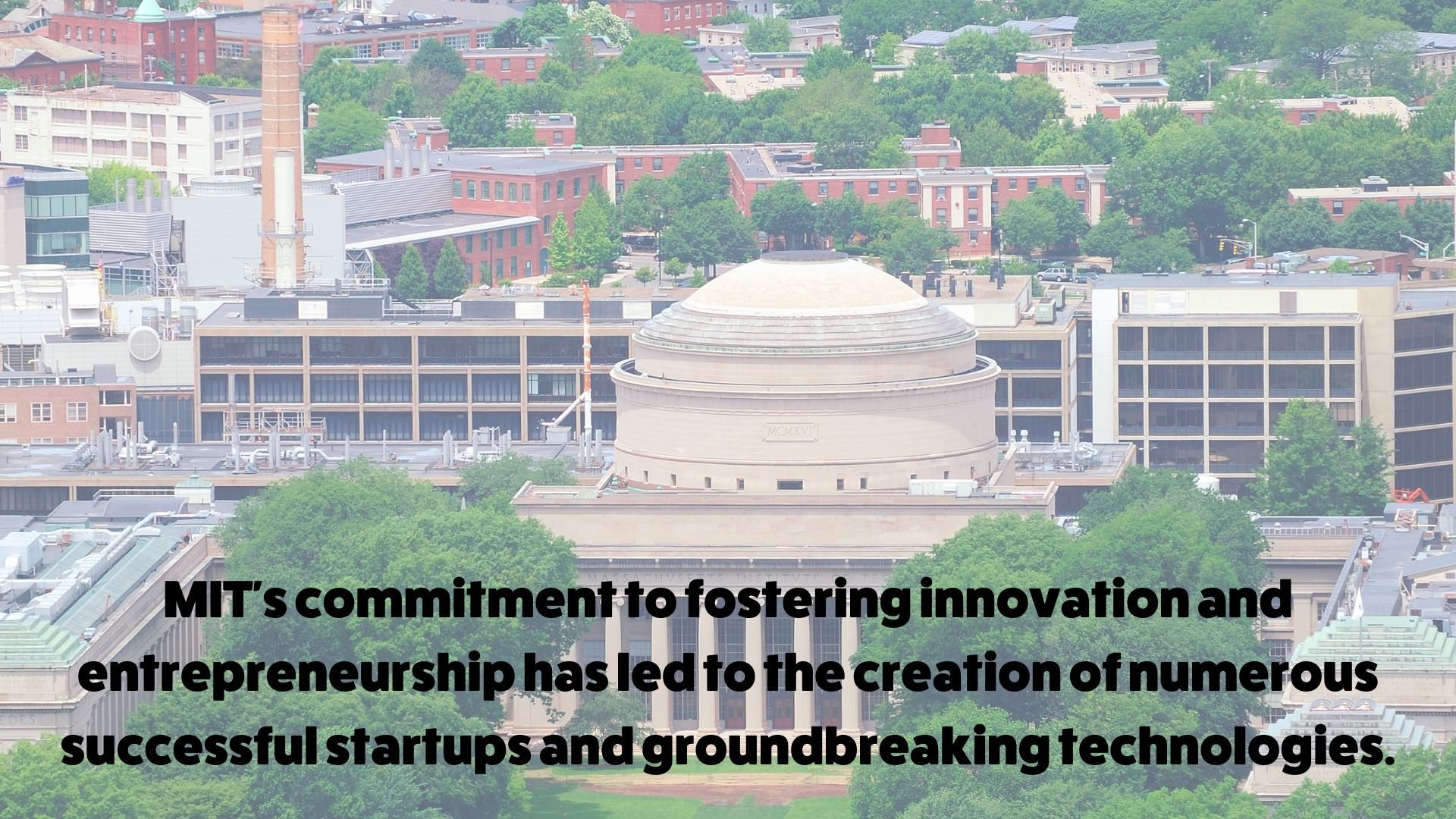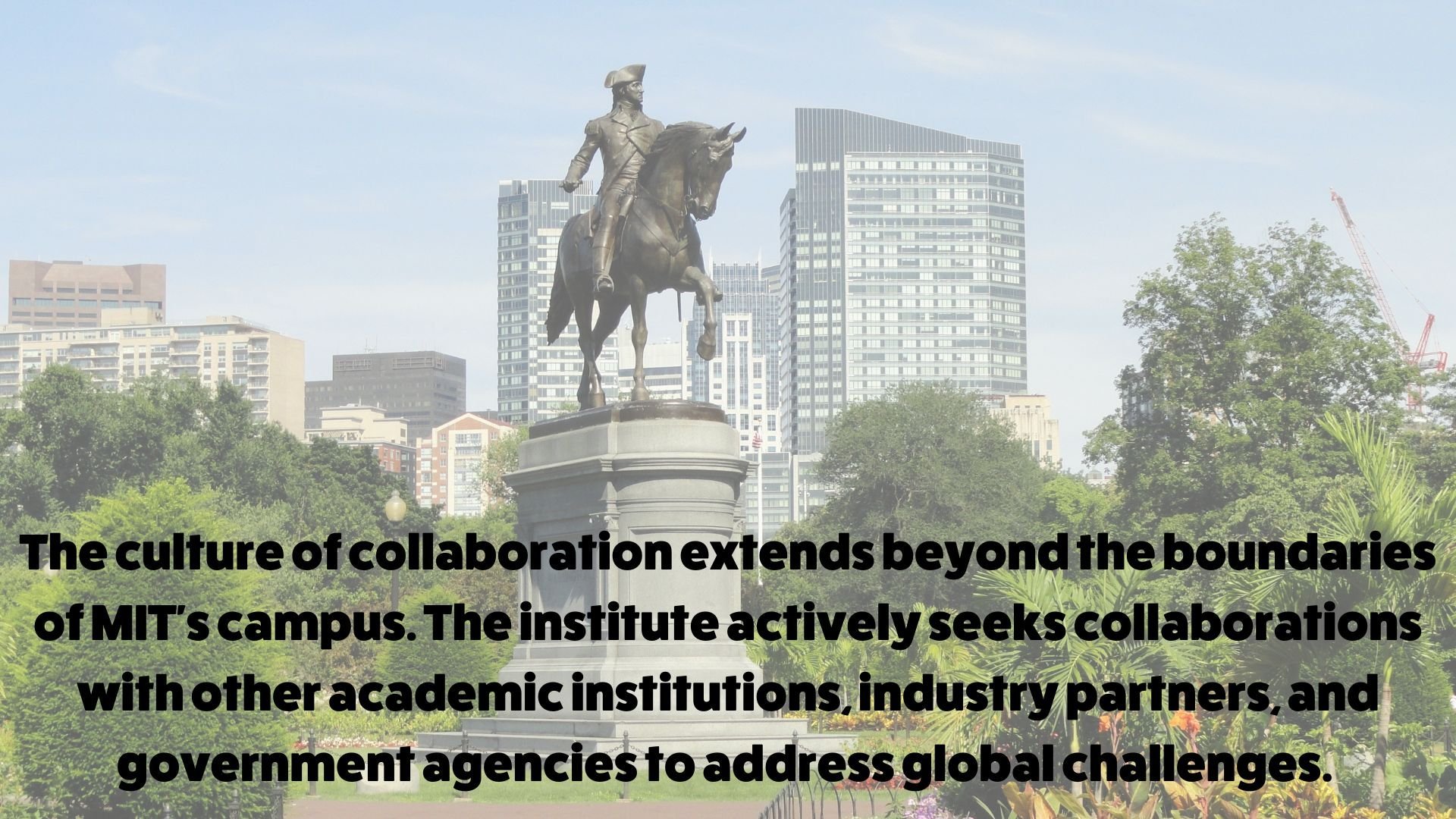What is MIT Known For? Exploring MIT's Legacy
When it comes to prestigious educational institutions, the Massachusetts Institute of Technology (MIT) is a name that resonates with excellence and innovation. Established in 1861, MIT has cultivated a reputation for pushing the boundaries of scientific advancement and nurturing some of the brightest minds in the world. This iconic institution has contributed significantly to various fields, shaping technology, research, and entrepreneurship. From its historic campus in Cambridge, Massachusetts, MIT has become synonymous with groundbreaking discoveries and transformative inventions.
Throughout its rich history, MIT has been at the forefront of technological advancement, making profound contributions that have shaped the world we live in today. From pioneering developments in electrical engineering and computer science to groundbreaking research in artificial intelligence, robotics, and space exploration, MIT has consistently been a driving force of innovation. The institute's collaborative and interdisciplinary approach to research and education has fostered an environment that encourages creativity, problem-solving, and intellectual rigor.
Interested in showcasing your intellectual vitality and initiative during high school? Find out how YOU can apply artificial intelligence to the subjects that interest you in InspiritAI’s AI Scholars Program. Students in the Inspirit AI Scholars program craft interdisciplinary AI projects engaging subjects of personal interest to them. Additionally, many students who have participated in the AI+X Individual Research Mentorship have gone on to win prestigious awards at various science fair competitions!
In this blog post, we will delve into MIT's legacy of technological advancement, exploring its notable achievements, groundbreaking research, and the impact it has had on various industries and society as a whole. Join us on a captivating journey through the corridors of this renowned institution as we uncover what MIT is truly known for.
What is MIT known for?
A LEGACY OF TECHNOLOGICAL ADVANCEMENT
MIT's legacy is intricately woven with remarkable technological advancements that have transformed industries and influenced society. From pioneering work in electrical engineering to groundbreaking research in artificial intelligence and robotics, MIT has consistently led the charge. Notable achievements include the development of early computer systems, foundational research in cybersecurity, and contributions to space exploration through collaborations with NASA.
1. Electrical Engineering and Computer Science
MIT has been a pioneering force in the realm of electrical engineering and computer science. The institute's faculty and alumni have played instrumental roles in developing key technologies, such as integrated circuits, computer networks, and programming languages. The birthplace of hacker culture, MIT has fostered an environment that encourages exploration, innovation, and collaboration, giving rise to groundbreaking projects like the first video game and the World Wide Web Consortium (W3C).
MIT's contributions to the field of electrical engineering include the development of the Whirlwind computer, one of the world's first real-time digital computers, and the pioneering work of Claude Shannon, the father of modern digital circuit design and information theory. Additionally, the development of the MIT Time-Sharing System (1961), which allowed multiple users to access a computer simultaneously, laid the foundation for modern computer networking and the concept of time-sharing operating systems.
In the realm of computer science, MIT has been at the forefront of innovation. The Lisp programming language, developed at MIT in the late 1950s, became one of the most influential languages in the field of artificial intelligence and symbolic processing. The MIT Media Lab, established in 1985, has been instrumental in bridging technology and creativity, giving birth to advancements in digital media, human-computer interaction, and wearable technology.
2. Robotics and Artificial Intelligence
MIT has a long-standing history of excellence in robotics and artificial intelligence (AI). Researchers and students have made remarkable advancements in the development of intelligent machines, autonomous systems, and human-robot interaction. Projects like the DARPA Robotics Challenge and the MIT Media Lab have propelled robotics into the mainstream, while influential AI research from MIT has had a profound impact on various industries, including healthcare, finance, and transportation.
MIT's robotics initiatives have led to groundbreaking achievements such as the development of advanced humanoid robots like Atlas and Cheetah. These robots showcase the capabilities of dexterous manipulation, mobility, and agility, and have the potential to revolutionize industries ranging from manufacturing to disaster response.
In the field of AI, MIT researchers have made significant contributions to natural language processing, computer vision, and machine learning. The development of technologies like the Open Mind Common Sense project, which aims to create a machine-readable database of human knowledge, and the breakthrough research on deep learning algorithms have pushed the boundaries of AI and opened up new possibilities in areas such as autonomous vehicles, personalized medicine, and intelligent virtual assistants.
3. Space Exploration
MIT's contributions to space exploration are substantial. Collaborations with NASA have resulted in major breakthroughs, including the development of the guidance systems used in the Apollo Moon landing missions. Additionally, MIT's involvement in the design and operation of satellites and space probes has expanded our understanding of the universe and paved the way for future space missions.
The MIT Instrumentation Laboratory, now known as the Charles Stark Draper Laboratory, played a critical role in the success of the Apollo program. The team at MIT developed the Apollo Guidance Computer, a groundbreaking onboard computer system that enabled precise navigation and control of the spacecraft. This technology was instrumental in the success of the Apollo missions, including the historic Apollo 11 moon landing in 1969.
MIT's contributions to space exploration extend beyond the Apollo program. The institute has been involved in the design and development of satellites and space probes that have expanded our knowledge of the universe. For example, MIT's involvement in the design and operation of the Transiting Exoplanet Survey Satellite (TESS) has revolutionized our understanding of exoplanets and their potential habitability. TESS has discovered thousands of exoplanet candidates, providing valuable data for scientists to study the possibility of life beyond our solar system.
Furthermore, MIT's contributions to space exploration extend to cutting-edge research in areas such as astrophysics, planetary science, and space propulsion. Faculty and researchers at MIT are actively engaged in studying cosmic phenomena, including black holes, gravitational waves, and the formation of galaxies. MIT's Kavli Institute for Astrophysics and Space Research serves as a hub for interdisciplinary research, fostering collaborations with leading institutions worldwide.
FOSTERING INNOVATION AND ENTREPRENEURSHIP
In addition to its technological advancements, MIT has cultivated an ecosystem that nurtures innovation and entrepreneurship. The institute's emphasis on practical problem-solving and interdisciplinary collaboration has empowered countless entrepreneurs and innovators to transform their ideas into successful ventures.
1. The MIT Entrepreneurship Ecosystem
MIT's commitment to fostering entrepreneurship is evident through its robust ecosystem of programs and resources. The Martin Trust Center for MIT Entrepreneurship serves as a hub for aspiring entrepreneurs, offering mentorship, workshops, and networking opportunities. It provides guidance and support at every stage of the entrepreneurial journey, from idea generation to venture creation and growth. The center's educational programs, such as the Entrepreneurship Development Program (EDP) and the delta v accelerator, provide a hands-on learning experience and access to a network of experienced entrepreneurs and investors.
2. MIT Media Lab
The MIT Media Lab deserves special mention for its groundbreaking work at the intersection of technology, art, and design. This interdisciplinary research laboratory has been the birthplace of numerous innovative projects, from 3D printing to wearable technology. Its focus on pushing boundaries and exploring novel ideas has attracted visionary researchers, artists, and engineers.
The Media Lab encourages experimentation and collaboration, providing a fertile ground for groundbreaking inventions. The lab's unique structure, which encourages cross-disciplinary collaboration, allows researchers to combine their expertise to tackle complex challenges. The lab's alumni have gone on to launch successful startups, such as E Ink, which revolutionized the e-paper industry.
3. Industry Partnerships and Technology Transfer
MIT has established strong partnerships with industry leaders, facilitating the transfer of technology and knowledge from the institute to the commercial sector. These partnerships enable researchers and students to work closely with industry professionals, gaining insights into real-world challenges and opportunities.
The MIT Industrial Liaison Program (ILP) acts as a bridge between MIT and industry, fostering collaboration and knowledge exchange. Through the ILP, companies gain access to cutting-edge research, and MIT benefits from industry insights and funding opportunities.
Additionally, MIT's Technology Licensing Office (TLO) plays a vital role in commercializing technologies developed at the institute. The TLO helps researchers and inventors navigate the complexities of intellectual property protection, licensing agreements, and startup formation. It ensures that innovative ideas and inventions generated at MIT have a pathway to market, contributing to economic growth and societal impact.
MIT's commitment to fostering innovation and entrepreneurship has led to the creation of numerous successful startups and groundbreaking technologies. The institute's ecosystem empowers aspiring entrepreneurs, facilitates collaborations with industry, and provides the necessary resources to turn innovative ideas into reality. By fostering a culture of innovation and providing the infrastructure for entrepreneurial endeavors, MIT continues to drive economic growth and create a positive impact on society.
A CULTURE OF INTELLECTUAL RIGOR AND COLLABORATION
At the heart of MIT lies a culture that fosters intellectual rigor and collaboration. This unique culture permeates every aspect of the institution, from its rigorous academic programs to its research endeavors. The commitment to excellence and the pursuit of knowledge shapes the experiences of students, faculty, and researchers at MIT.
1. Rigorous Academic Programs
MIT's academic programs are renowned for their rigorous nature, challenging students to reach their full intellectual potential. The institute's commitment to academic excellence ensures that students are equipped with a deep understanding of their chosen fields.
MIT offers a wide range of undergraduate and graduate programs across various disciplines, including engineering, science, architecture, management, and the humanities. The curriculum is designed to provide a solid foundation in fundamental principles while also encouraging students to explore their interests through elective courses and research opportunities.
The academic programs at MIT emphasize critical thinking, problem-solving, and hands-on learning. Students are encouraged to engage in independent research projects, collaborate with faculty members, and apply their knowledge to real-world challenges. The rigorous coursework, coupled with a supportive and intellectually stimulating environment, nurtures a culture of academic excellence that prepares students for success in their chosen careers.
Furthermore, MIT's academic programs promote interdisciplinary approaches, allowing students to explore connections between different fields of study. This interdisciplinary approach fosters creativity and innovation, enabling students to tackle complex problems from multiple perspectives.
The rigorous academic programs at MIT not only provide students with a strong educational foundation but also cultivate a mindset of continuous learning and intellectual curiosity. Graduates of MIT are equipped with the knowledge, skills, and resilience to thrive in a rapidly evolving world and make significant contributions to their respective fields.
2. Collaborative Research Environment
Collaboration is a cornerstone of MIT's research culture. The institute attracts brilliant minds from diverse disciplines, creating an environment that fosters interdisciplinary collaboration and cross-pollination of ideas. Researchers and students work together on cutting-edge projects that address complex global challenges.
MIT's research centers, such as the MIT Media Lab, the MIT Computer Science and Artificial Intelligence Laboratory (CSAIL), and the Broad Institute of MIT and Harvard, provide platforms for collaboration across disciplines. These centers bring together experts from various fields to work on interdisciplinary projects that tackle grand societal challenges. The collaborative nature of research at MIT not only accelerates the pace of innovation but also allows for a holistic understanding of complex problems.
The institute also promotes collaboration through its vibrant academic community. Faculty members actively engage with students and fellow researchers, fostering a culture of mentorship and intellectual exchange. Students are encouraged to seek guidance from experienced faculty members, collaborate with their peers, and participate in research symposiums and conferences.
The culture of collaboration extends beyond the boundaries of MIT's campus. The institute actively seeks collaborations with other academic institutions, industry partners, and government agencies to address global challenges. These collaborations amplify the impact of research and ensure that the knowledge generated at MIT reaches a wider audience, leading to meaningful advancements in various fields.
IMPACT ON SOCIETY AND GLOBAL OUTREACH
MIT's influence extends far beyond its campus borders, with a profound impact on society and a commitment to global outreach. The institute actively seeks to address pressing global challenges and create positive change through its research, educational initiatives, and partnerships.
1. Addressing Global Challenges
MIT is dedicated to leveraging its expertise and resources to address pressing global challenges. Through its research initiatives, faculty and researchers collaborate on multidisciplinary projects aimed at finding innovative solutions. From developing sustainable energy technologies to advancing healthcare delivery systems, MIT's research efforts have a direct impact on improving lives worldwide.
MIT's commitment to addressing global challenges extends beyond the confines of its campus. The institute actively engages with global partners, governments, and organizations to tackle issues such as climate change, poverty, and healthcare disparities. Collaborative projects focus on developing sustainable solutions, promoting social entrepreneurship, and creating equitable access to resources and opportunities.
Moreover, MIT's emphasis on entrepreneurship and innovation contributes to addressing global challenges by fostering the development of scalable and impactful solutions. Through entrepreneurship programs, incubators, and competitions, MIT encourages students and researchers to turn their ideas into tangible solutions that address global problems.
By actively engaging in research and collaboration, MIT demonstrates its commitment to making a positive impact on society and finding sustainable solutions to the world's most pressing challenges.
2. Educational Initiatives and Access
MIT is deeply committed to expanding access to quality education and promoting educational initiatives on a global scale. The institute recognizes that knowledge knows no boundaries and strives to make educational resources available to learners worldwide.
Through initiatives like MIT OpenCourseWare and MITx, the institute offers free and open access to a vast array of educational materials and online courses. Learners from all walks of life can access lectures, course materials, and assignments, enabling self-paced learning and exploration of diverse subjects.
Furthermore, MIT actively engages in partnerships with educational institutions, governments, and organizations to enhance STEM education, teacher training, and access to education globally. Collaborative initiatives aim to inspire and empower learners, particularly in underserved communities, by providing mentorship, resources, and guidance.
MIT's commitment to educational access also extends to its scholarship and financial aid programs. The institute strives to ensure that deserving students, regardless of their financial backgrounds, have the opportunity to pursue their education at MIT.
By leveraging technology and forging partnerships, MIT is democratizing education and bridging educational gaps, allowing individuals around the world to gain knowledge and skills that can positively impact their lives and communities.
3. Global Partnerships and Collaborations
MIT recognizes the power of global partnerships and collaborations in addressing complex global challenges. The institute actively engages in collaborations with academic institutions, industry partners, and governments worldwide, fostering knowledge exchange and amplifying the impact of its research efforts.
Through international collaborations, MIT cultivates a diverse and inclusive research community, bringing together experts from different backgrounds and perspectives. Collaborative projects tackle a wide range of global issues, including climate change, sustainable development, healthcare innovation, and technological advancements.
These partnerships enable researchers and students at MIT to work alongside global counterparts, sharing expertise, resources, and innovative ideas. By pooling their collective knowledge and resources, these collaborations drive advancements in various fields, often leading to groundbreaking discoveries and transformative solutions.
MIT's global partnerships also extend to joint research projects, student exchange programs, and collaborative initiatives. These efforts promote cultural understanding, facilitate the exchange of best practices, and foster collaboration in areas of mutual interest. The institute actively seeks opportunities to collaborate with international institutions, industry leaders, and governments, recognizing the importance of collective action in addressing global challenges.
Through these global partnerships and collaborations, MIT contributes to the global scientific community, promotes cross-cultural understanding, and accelerates the pace of innovation. By combining the strengths of diverse stakeholders, MIT strives to create meaningful and sustainable impact on a global scale.
Conclusion
MIT stands as a beacon of excellence, innovation, and impact. From its legacy of technological advancements to its fostering of innovation and entrepreneurship, MIT has made remarkable contributions that have shaped industries, improved lives, and advanced society as a whole. Its culture of intellectual rigor and collaboration has nurtured countless brilliant minds and propelled groundbreaking research.
Through its commitment to addressing global challenges, promoting educational initiatives, and fostering partnerships, MIT actively works to create a better future for all. Its impact extends far beyond the confines of its campus, reaching individuals, communities, and industries worldwide.
MIT's pursuit of knowledge, its dedication to making education accessible, and its collaborative approach to research and innovation have positioned it as a global leader in science, technology, and education. As we look ahead, we can only anticipate that MIT will continue to push the boundaries of knowledge, drive meaningful change, and inspire the next generation of thinkers, innovators, and problem-solvers.
About Inspirit AI
AI Scholars Live Online is a 10 session (25-hour) program that exposes high school students to fundamental AI concepts and guides them to build a socially impactful project. Taught by our team of graduate students from Stanford, MIT, and more, students receive a personalized learning experience in small groups with a student-teacher ratio of 5:1.



